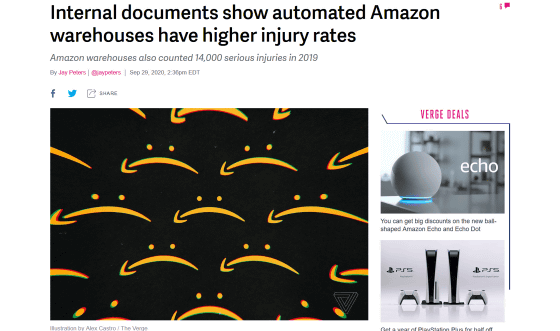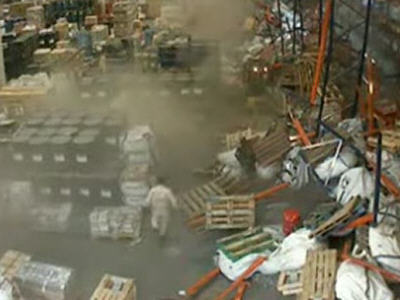It is pointed out that the incidence of 'serious injuries' in Amazon warehouses is twice the industry average, and the injury rate is particularly high in highly automated warehouses.

Amazon's vast warehouses around the world are lined with large quantities of merchandise, playing an important role in extracting, boxing, and delivering merchandise purchased online by users. In such Amazon warehouses, the incidence of serious employee injuries is twice the industry average, and it is reported that the injury rate is particularly high in warehouses where robots have been introduced and automation has progressed.
Amazon's internal records show its worker safety deception
Amazon's rate of serious warehouse injury is double the industry standard
https://www.inputmag.com/tech/amazons-warehouse-injury-rate-is-double-the-industry-standard
Internal documents show automated Amazon warehouses have higher injury rates --The Verge
https://www.theverge.com/2020/9/29/21493752/amazon-warehouses-robots-higher-injury-rates-report-reveal

Amazon, which is promoting the automation of warehouse work by introducing robots, claims that the burden on workers will be reduced and accidents will be reduced by having robots carry out various tasks. However, according to Amazon's internal records obtained by overseas media
According to a Reveal report, as many as 14,000 employees were 'seriously injured' in Amazon warehouses in 2019, with an 33% increase in injury rate per 100 employees compared to 2016. It is said that there is. In addition, 'serious injury' here means an injury that causes you to take a break from work or set restrictions on work due to the injury.
The graph below shows the 'serious injury rate' per 100 people in the warehouse from 2016 to 2019, with the light blue line showing the injury rate in the Amazon warehouse and the gray line showing the industry average injury rate. I will. While the industry average injury rate is about 4 per 100 people, the injury rate of Amazon warehouse is close to 8, and it can be seen that nearly twice the average number of workers are injured in Amazon warehouse. I will.

In addition, surprisingly, the injury rate is particularly high in the Amazon warehouse where the introduction of robots has progressed. In the graph below, the dark blue line shows the injury rate of 'Amazon warehouse with advanced robot introduction', the light blue line shows the injury rate of 'Amazon warehouse with less advanced robot introduction', and the gray line shows the industry average injury rate. I will. It can be seen that the injuries rate is higher in warehouses that are more automated by robots.

The robot introduced in the Amazon warehouse ran around the warehouse to move the shelves containing the products and delivered the products directly to the workers, greatly reducing the time required to take out and pack the products. .. Initially, workers also welcomed this change, as robots move around the warehouse to carry goods, reducing the need for workers to roam the warehouse in search of specific goods.
However, as a result of the increased efficiency of the introduction of robots, the quota that each worker has to deal with has increased significantly. For example, a worker called a 'picker' who grabs and scans products had a quota of scanning 100 products per hour before the introduction of the robot, but after the introduction of the robot, the quota increased to 400 per hour. It seems that it was done. Workers were forced to grab and process large quantities of goods around the clock, increasing the number of simple repetitive tasks that overworked certain parts of the body, resulting in an increased risk of injury.
The US
Input from overseas media pointed out that Amazon's innovation, such as the delivery of goods to consumers immediately after ordering, is based on the exploitation of workers. Amazon, which has gained a large share due to services such as free shipping and convenience, could not make improvements such as reducing the allocation to workers and increasing paid leave, and the lowest level workers were wrinkled. Insisted that there was.

by Tony Webster
Related Posts:
in Note, Posted by log1h_ik







